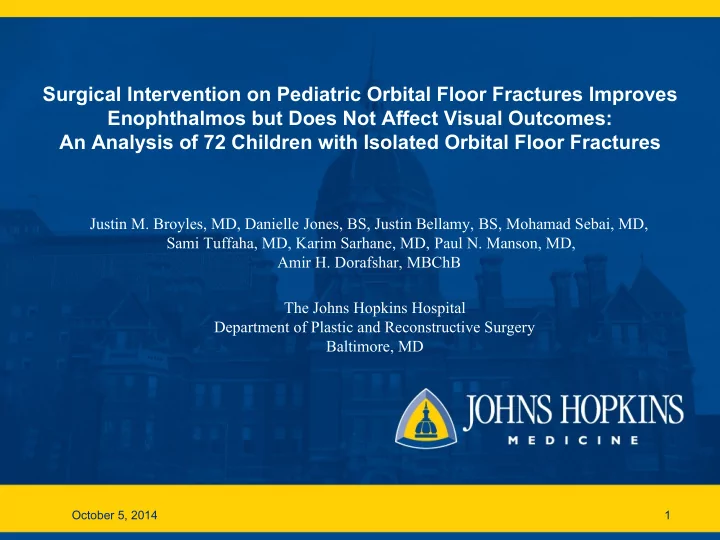

Surgical Intervention on Pediatric Orbital Floor Fractures Improves Enophthalmos but Does Not Affect Visual Outcomes: An Analysis of 72 Children with Isolated Orbital Floor Fractures Justin M. Broyles, MD, Danielle Jones, BS, Justin Bellamy, BS, Mohamad Sebai, MD, Sami Tuffaha, MD, Karim Sarhane, MD, Paul N. Manson, MD, Amir H. Dorafshar, MBChB The Johns Hopkins Hospital Department of Plastic and Reconstructive Surgery Baltimore, MD October 5, 2014 1
Nothing to disclose October 5, 2014 2
BACKGROUND • Pediatric facial fractures are common • Periorbital fractures are the third most common facial fracture 1 • Established algorithms for adult orbital floor fracture management • Management of pediatric floor fractures is controversial 1. Gerber, Barbara, Paul Kiwanuka, and Daljit Dhariwal. "Orbital Fractures in Children: A Review of Outcomes." British Journal of Oral and Maxillofacial Surgery 51.8 (2013): 789-93 October 5, 2014 3
BACKGROUND Figure from:Alcala-Galiano, A., I. J. Arribas-Garcia, M. A. et al.. "Pediatric Facial Fractures: Children Are Not Just Small Adults." Radiographics 28.2 (2008): 441-61. October 5, 2014 4
CLINICAL PRESENTATIONS Restricted Upward Gaze Enophthalmos Wei, Leslie A, et al, "Pediatric Orbital Floor Fractures." Journal of American Association for Pediatric Ophthalmology and Strabismus 15.2 (2011): 173-80. October 5, 2014 5
PURPOSE • Aims : – Determine defect/orbit width ratio that is associated with the development enophthalmos – Predict long-term visual outcomes in children who present with visual disturbances October 5, 2014 6
METHODS • Retrospective review, 1991-2012 • 72 Children with isolated orbital floor fractures • 76 Fractures • Chart and radiographic review – Panoramic radiographs (66%) – Computed tomography (34%) October 5, 2014 7
RADIOGRAPHIC EVALUATION October 5, 2014 8
DEMOGRAPHICS 69% (50/72) MALE AGE: 8.4 YRS +/- 4YRS FOLLOW-UP: 14 MONTHS October 5, 2014 9
RESULTS: MANAGEMENT • 33% Treated surgically • Surgical indications: – Size of fracture (65%) – Entrapment (17%) P<0.05 SURGERY CONSERVATIV E Defect Width 20.7 7.8 (mm) Defect/Orbit 0.54 0.32 Width ratio October 5, 2014 10
RESULTS: VISUAL ACUITY PRESENTATION FOLLOW-UP Visual Acuity: Visual Acuity: – 19% Decreased (14/72) – Unchanged 50% (7/14) – 81% Unchanged (58/72) – Decreased 7% (1/14) – Improved 43% (6/14) October 5, 2014 11
RESULTS: ENOPHTHALMOS ON ADMISSION AT FOLLOW-UP • 8% (6/72) • 4% (3/72) – 4 Managed surgically – Managed conservatively • Complete resolution • Complete resolution – 2 Managed conservatively • Complete resolution October 5, 2014 12
RESULTS: SURGICAL OUTCOMES ENOPHTHALMOS IMPROVEMENT VISUAL ACUITY SURGERY RR: 0.02 NS CI 0-0.49, p<0.05 October 5, 2014 13
CONCLUSIONS • Surgical correction of floor defects eliminates enophthalmos • However, enophthalmos, either acute or delayed, can potentially resolve without surgery • Surgery does not improve visual acuity in patients presenting with decreased vision • A definite defect/orbital width ratio for surgical intervention remains to be determined October 5, 2014 14
Recommend
More recommend